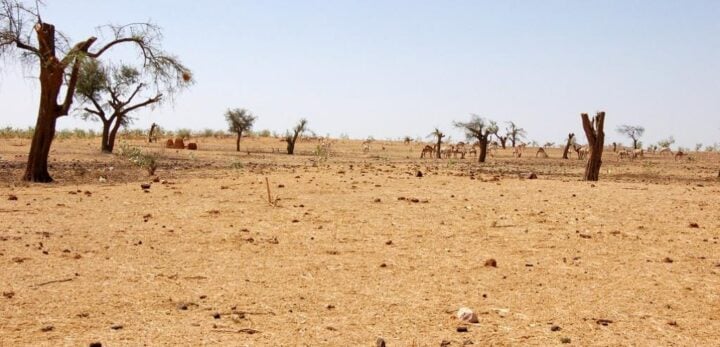BY ADEDOKUN SEYI
There is a brewing toll of climate change on Nigeria’s ecosystems and economy which cannot be overstated as the Vice President, Kashim Shettima, has said that over 90% of the country’s original forest cover has been lost to environmental and economic harshness. In Sokoto state, for example, rivers that once irrigated staple crops now run dry as smallholder farmers like Umaru Muazu say their millet and maize yields have halved. With little access to new wells or drip irrigation, many face mounting debt just to hope for a harvest.
Sokoto’s near-total tree loss, over two-thirds of local forest cover vanished, has accelerated land degradation and intensified heat spells, pushing yields ever lower. More than 31 million Nigerians face acute food insecurity, and smallholders producing roughly 90% of the nation’s food bear the brunt of this decline. Yobe and Jigawa states experience crippling desertification at 0.6 km per year, eating up as many as 400,000 ha of farmland annually.
Farmers report soil so infertile that even replanting fails. As crop yields worsen, pest invasions, livestock disease and higher irrigation charges now consume up to ₦120 billion a year in Northern Nigeria alone. From 2020 to 2023, agricultural sector growth dropped from 2.17% to just 1.19%, despite government pledges to activate half a million hectares of northern landbanks and it is still unfulfilled by mid-2025.
Advertisement
The country experienced its worst inundation in a decade as over 1.4 million Nigerians displaced, more than 600 dead, and over 440,000 ha of farmland destroyed in 2022, causing economic loss estimated at US$6.68 billion. In Adamawa state alone, 131,638 residents were displaced when riverbanks overflowed, and farms and infrastructure across more than 150 communities lay in ruin. Bayelsa state saw at least 1.3 million people displaced as coastal communities succumbed to steady inundation triggered by dam release upstream and relentless rainfall. More recently, in May 2025, the town of Mokwa in Niger state was submerged in a catastrophic flood following dam collapse and extreme rainfall, killing many people, injuring hundreds, leaving people missing and destroying over 4,000 homes and critical infrastructure.
In Chad and Niger, rising floods displaced millions during West and Central African weather crises but their lower population densities and fewer coastal urban centres reduced economic fallout compared to Nigeria. Even countries like Bangladesh, with better early warning systems and flood engineering investments, manage floods without triggering systemic food shortages and runaway urban migration.
Within Nigeria, climate impacts have suppressed agricultural growth to below 1% annually between 2022 and 2024. At the same time, food inflation peaked at over 40% in 2024, forcing households to skip meals and pushing millions into poverty. Ecosystem loss erodes food production, flood and drought shocks reduce economic output, and weakened GDP constrains adaptation investments, and shortages and inflation further fuel social instability.
Advertisement
Forests worldwide have lost around 178 million ha since 1990, though net losses have declined from 7.8 M ha/yr (1990–2000) to 4.7 M ha/yr (2010–2020). Developed regions like Europe and North America now see net reforestation, while Africa continues to lose about 3.9 M ha annually. Key success stories include the United States, where heavy past deforestation reversed in the mid-20 th century.
Forest cover has been steadily increasing at ~0.03% per year between 2010 and 2020. European nations have similarly expanded forests through reforestation, strong regulation, and afforestation incentives. In tropical Africa, forest loss reaches alarming levels.
Since 1900, tropical regions have lost roughly 22% of their forested land, comparable to Amazon rates. Côte d’Ivoire and Ghana lost approximately 80% of forests between 1900 and 2021 from agricultural expansion, while Kenya dropped from 10% to 1.7% forest cover between 1963 and 2006. Madagascar lost over 90% of its original forest, and Ethiopia has only 2% remaining.
Costa Rica (Central America) succeeded through government-backed payments for ecosystem services, enforcing national reforestation targets, and eco-tourism models. Brazil’s five-year moratorium on Amazon soy deforestation reduced rates, though recent rollbacks threaten progress. Nigeria’s forest picture is distressing as forest cover dropped from about 26.5 M ha in 1990 to 21.6 M ha by 2020, a net loss around 163,000 ha yearly.
Advertisement
Global Forest Watch records 2024 losses of about 253,000 ha, emitting about 114 Mt CO₂. FAO data show Nigeria has the highest global annual % loss (5 %) between 2010 and 2015. Drivers are primarily subsistence agriculture which contributes 60% and fuel wood collection, aggravated by poverty as half of poor Nigerians constitute 80% rural, population surge, weak enforcement, institutional weakness, and governance lapses. Protected areas like Edo, Cross River, Taraba, and Ondo states lose forest at worse rates with decline of 12% since 2000.
Weak accountability at both federal and state levels introduces risks of fund misappropriation. Also, security challenges including illegal logging backed by corruption, or forest encroachment supported by collusion in agency bureaucracies threaten enforcement unless security agencies like the Nigerian Forest Security Service are empowered and safeguarded.
Climate finance pipelines often come with stringent donor conditions, making bureaucracy and transparency essential or funding will be withheld. And markets such as the EU’s anti‑deforestation due diligence regulation will require robust supply‑chain traceability, absent which Nigerian producers could be excluded.
Amidst this, the EU is tightening import rules like anti-deforestation regulation, supply chain due diligence, which Nigeria fears could hurt agro-exports. The EU’s Regulation, coming fully into effect in 2025, prohibits deforestation-linked commodities like cocoa and palm oil, requiring chain-of-custody proof.
Advertisement
By inference, Nigeria must build the institutional capacity to comply, or risk losing access to key markets. Brazil’s Amazonian deforestation slowdown correlated with moratoria on soy and cattle, plus REDD+ payments. Payment for Ecosystem Services schemes, where communities are paid to maintain forests, are used in Costa Rica and parts of Europe but Nigeria’s REDD+ national strategy launched in 2023 currently lacks funding and local engagement.
In Kenya, shifting to agroforestry and small-scale woodlot creation, coupled with community-based forest management, helped forest regeneration. Nigeria’s lack of village forest committees or tree tenure rights in law impedes similar strategies. In addition, satellite-based deforestation detection platforms like Global Forest Watch have proven effective in Brazil and Peru to deploy real-time anti-logging enforcement and direct funds.
Advertisement
While Nigeria’s federal government announced a chase of $2 billion forest economy fund, state-level implementation often falters due to overlapping jurisdictions as Nigeria is divided into 36 states and each with its own policies and complicating unified action. Corruption and lack of law enforcement exacerbate illegal logging. The federal government’s top-down rhetoric has yet to translate into proper funding, accountability, or rural community engagement.
One key step to combating deforestation and promoting sustainable forest management to protect livelihood in agriculture and prevent nutrient wash-way from top soil is scaling up Payment for Ecosystem Services (PES) and REDD+ initiatives, linking them to global carbon markets by channelling international funds such as the Green Climate Fund through transparent, village-level forest stewardship systems.
Advertisement
Empowering community forestry is also essential with legal frameworks that grant tenure and management rights to local communities. Harmonising federal and state policies will ensure consistency in forest definitions, land-use permits, and enforcement penalties across the country. Investments in satellite-based monitoring technologies can enhance real-time surveillance of deforestation, enabling more effective resource allocation and enforcement.
Sustainable agroforestry should be promoted through the provision of subsidised seeds, training programmes, and access to credit for tree-crop intercropping. Nigeria must also build its capacity to comply with export standards such as the EU’s Deforestation Regulation by mapping supply chains and issuing deforestation-free certifications.
Advertisement
A moratorium on the conversion of forests for high-risk commodities could serve as a necessary short-term measure to protect vital ecosystems. The country should prioritise climate-smart economic diversification, boosting sectors like ecotourism, sustainable timber, and the production of non-timber forest products such as medicinal plants and honey
To operationalise this vision, Nigeria must rigorously reform both institutional structures and policy instruments. First, the national Council on Climate Change which oversees Climate Act implementation must enable sub‑national nodes in each state with clear roles in forest carbon budgeting, registry, and REDD+ planning. Second, forest governance must shift from revenue-first to collaboration-first.
State governments should establish independent forestry commissions with fiscal autonomy and management oversight, enabling them to hold logging permits accountable, reinvest fees into regeneration programs, involve communities and civil society, and deploy modern tools like drones and geospatial mapping to track change.
Third, establishing community-based natural resource management (CBNRM) structures with incentives such as service-based payments, extension support, and clean energy alternatives can create stewardship and transform forest users into partners rather than adversaries. But to work, such models must include livelihood diversification in sustainable agroforestry systems, regulated fuel-wood harvesting, and training for local communities in governance and regeneration practices. Fourth, Nigeria must harness existing climate finance frameworks and climate diplomacy.
The Kunming–Montreal Global Biodiversity Framework calls for at least USD 20 billion in biodiversity finance by 2025 for Global South countries which Nigeria can access a share of that by demonstrating credible commitments like its National Climate Change Fund, effective carbon budgeting, improved monitoring systems, and proven local impact.
Yet climate finance flows into Nigeria remain modest relative to ambition and risk diversion or mismanagement if institutional transparency is not strengthened. Nigeria should leverage ecosystems like mangroves and park reserves to pilot Natural Capital Accounting approaches that value forests not just for timber but for carbon, biodiversity, and tourism potential.
If these reforms are adopted, Nigeria could establish well‑governed, multi‑stakeholder forest management systems delivering measurable carbon sequestration, resilient rural livelihoods, and export‑compliant supply chains. For instance, agroforestry corridors integrated with carbon projects could deliver local income, reduce subsistence clearing, and generate voluntary or compliance carbon credits. Mangrove restoration linked to eco‑tourism and coastal protection could generate dual benefits of carbon removal and disaster resilience.
National climate budgeting tied to forestry would enable greenhouse gas reductions while providing fiscal logic for tree planting and rehabilitation. Nigeria’s opportunity lies in translating global climate commitments into deeply rooted national reforms. These must unite robust legal frameworks like the Climate Change Act, decentralised and independent forestry agencies in all states, inclusive community governance, credible carbon accounting, and strategic access to global climate finance.
Focusing on ecosystem valuation, agrarian transformation through agroforestry, and forest economy options such as mangroves and ecotourism, Nigeria can build a forest-based development model. If implemented with transparency and accountability this integrated approach could transform Nigeria from a source of deforestation emissions into a leader in forest restoration, carbon sequestration, and climate‑resilient rural prosperity. Without systemic reform, however, even bold plans like the proposed $2 billion forest economy fund risk becoming costly but ineffectual gestures.
Seyi Adedokun is a Nigerian freelance writer and research enthusiast. He can be reached on [email protected]
Views expressed by contributors are strictly personal and not of TheCable.












